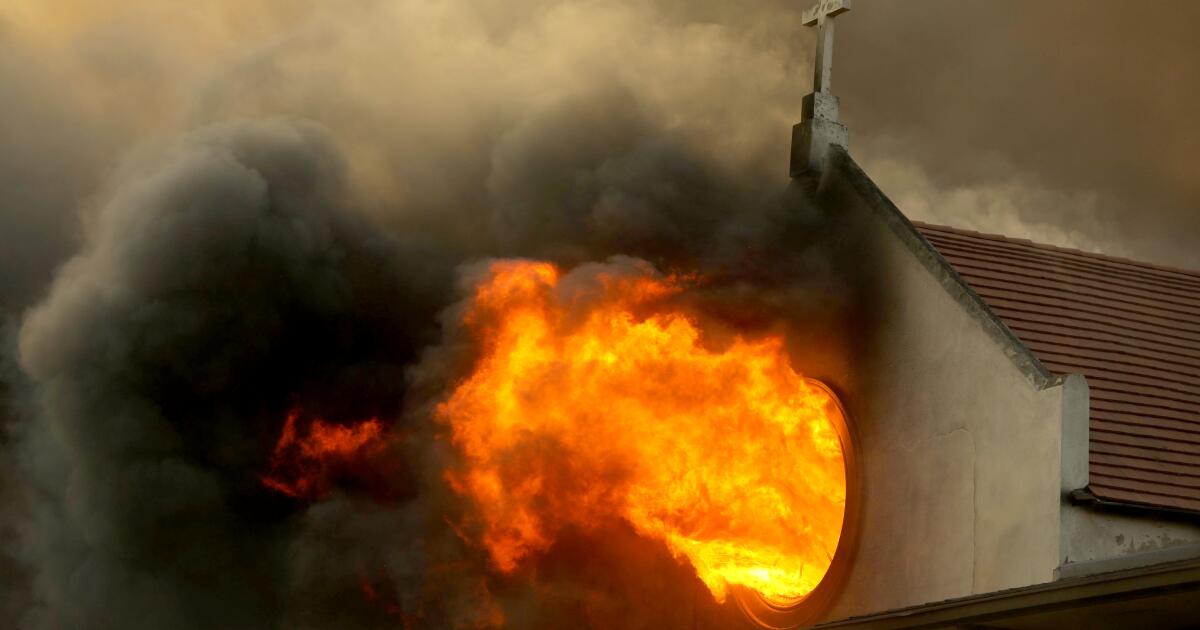Los Angeles firefighters will remain on duty for an additional shift during red flag weather warnings in a mandatory protocol instituted after top fire officials failed to pre-deploy engines to Pacific Palisades in advance of the devastating Jan. 7 fire.
Mayor Karen Bass’ announcement came after the Fire Department released a long-awaited after-action report finding that firefighters were hampered by an ineffective process for recalling them back to work, as well as poor communication, inexperienced leadership and a lack of resources.
The release of the 70-page report, and Bass’ recitation of changes the department has made in line with the report, came on the heels of federal prosecutors arresting and charging a 29-year-old Uber driver with intentionally setting a fire on Jan. 1 that later grew into the Palisades fire.
City officials said in August that at the request of federal officials, they were holding off on releasing their own report until the federal investigation into the cause of the blaze was complete.
A Times investigation published a week after the fire found that fire officials did not pre-deploy any engines to the Palisades before the flames erupted, despite warnings about extreme weather. The officials also did not require firefighters to stay for an additional shift.
In preparing for the winds, officials chose to staff up only five of more than 40 engines available to supplement the regular firefighting force. According to the after-action report, the firefighters who voluntarily returned could staff only three engines.
The additional engines could have been pre-positioned in the Palisades and elsewhere, as had been done in the past during similar weather.
The LAFD report said that at 8 a.m. the morning of the fire — about two hours before the flames erupted — fire officials decided to pre-deploy several additional engines, though none were sent to the Palisades.
During the initial battle with the flames, the report said, most firefighters worked for more than 36 hours without rest.
In an interview Wednesday, interim Fire Chief Ronnie Villanueva referenced a stronger pre-deployment model and said he has implemented leadership changes.
In addition to more training for firefighters, the Fire Department is upgrading its preparations for fires, which includes “moving resources into position earlier, giving every officer advance access to briefings, and holding tactical meetings more often,” Bass said in her list of changes related to the report.
“The decisions that they made on that day were adequate, I believe, in their decision making matrix. … Now, because of that, and because I came in and I got to see everything from a bird’s eye view, things needed to be changed,” Villanueva said. “So I made sure that our deployment model is heavy on resources, so that we have everybody placed in strategic areas to cover the city.”
In February, Bass removed Kristin Crowley, who was chief during the fire, replacing her with Villanueva.
Bass had criticized Crowley’s pre-deployment decisions and complained that Crowley didn’t contact her until after the fire broke out.
“We know that 1,000 firefighters that could have been on duty on the morning the fires broke out were instead sent home on Chief Crowley’s watch,” Bass said in a statement on Feb. 21 announcing Crowley’s firing.
Crowley, who still works for the Fire Department at a lower rank, appealed her demotion and has filed a legal claim against the city, alleging that Bass “orchestrated a campaign of misinformation, defamation, and retaliation” to protect her political image.
Crowley and other top fire officials contended at the time that they did the best they could with the budget and resources they had, also saying that more would not have made a difference against such a ferocious, wind-fueled fire.
Bass, who drew heavy criticism for being on a diplomatic trip to Ghana when the fire broke out, said the Fire Department has made 19 leadership changes, including Villanueva’s appointment, and is searching for a permanent chief.
“It is vital we learn from what was effective, like the relentless heroism of firefighters responding to the blaze, and the challenges we faced in order to build a stronger emergency response system to prepare for whatever may come our way,” Bass said in her statement.
The mayor and other key city leaders will be “explicitly notified by the LAFD as soon as possible and kept up-to-speed at all times during … any crisis,” she said.
The Fire Department report said that several top fire officials “had limited or no experience in managing an incident of such complexity.”
“Some were unfamiliar with their roles within the command and general staff and reverted to their previous knowledge at lower ranks, resulting in key command and staff positions remaining unfilled and associated tasks being neglected,” the report said.
The Palisades fire, which started at 10:30 a.m. Jan. 7, was one of the costliest and most destructive disasters in city history, leveling thousands of homes and killing 12 people.
Federal investigators announced Wednesday that the Jan. 7 fire was a so-called holdover from the Jan. 1 fire, which continued to smolder and burn underground after firefighters thought they had extinguished it. The investigators said that heavy winds six days later caused the underground fire to surface and spread above ground in what became one of the costliest and most destructive disasters in city history.
As residents desperately fled the flames, they got stuck on clogged roadways, and many abandoned their cars. The report cited a delay in communicating evacuation orders, which resulted in spontaneous evacuations without structured traffic control, causing people to block routes to the fire.
Bass said the department is working on new evacuation exercises with a software program, Genasys Protect, which will help with “proper and efficient civilian evacuation.”

